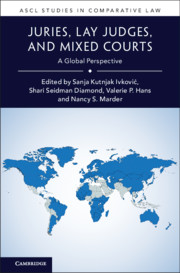Book contents
- ASCL Studies In Comparative Law
- Juries, Lay Judges, and Mixed Courts
- Copyright page
- Contents
- Editors
- Contributors
- Acknowledgments
- 1 Introduction
- Part I Advances in Lay Participation
- Part II Enduring Systems of Lay Participation
- Part III Challenges to Lay Participation in Law
- 10 Dismissing the Jury
- 11 Trials by Peers
- 12 The Russian Jury Trial
- 13 Trial by Jury in Georgia
- Part IV Global Perspectives on Lay Participation
- Name Index
- Subject Index
- References
10 - Dismissing the Jury
Mixed Courts and Lay Participation in Norway
from Part III - Challenges to Lay Participation in Law
Published online by Cambridge University Press: 03 August 2021
- ASCL Studies In Comparative Law
- Juries, Lay Judges, and Mixed Courts
- Copyright page
- Contents
- Editors
- Contributors
- Acknowledgments
- 1 Introduction
- Part I Advances in Lay Participation
- Part II Enduring Systems of Lay Participation
- Part III Challenges to Lay Participation in Law
- 10 Dismissing the Jury
- 11 Trials by Peers
- 12 The Russian Jury Trial
- 13 Trial by Jury in Georgia
- Part IV Global Perspectives on Lay Participation
- Name Index
- Subject Index
- References
Summary
This chapter argues that contemporary debates about the constitution and expansion of mixed courts in Norway reveal a tension in attitudes toward lay participation in the legal system. On the one hand, lawyers and laypersons in Norway evince confidence that professional legal actors can effectively collaborate with jurors to reach verdicts. On the other hand, both laypersons and attorneys worry that when it comes to the prosecution of some crimes – particularly sex crimes – laypersons cannot be relied upon to do justice. After offering an overview of Norway’s shifting jury system, the chapter argues that judicial interventions in the jury system have contributed to its gradual loss of legitimacy. Drawing on empirical research, I argue that critiques of rape prosecutions have both amplified and sharpened the stakes of critiques of lay participation more broadly, though – at least for the moment – mixed courts of lay and professional judges are perceived to remedy the shortcomings of all-layperson juries.
Keywords
- Type
- Chapter
- Information
- Juries, Lay Judges, and Mixed CourtsA Global Perspective, pp. 197 - 217Publisher: Cambridge University PressPrint publication year: 2021

